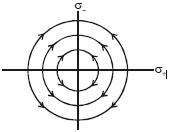Two charged thin infinite plane sheets of uniform surface charge density $\sigma_{+}$ and $\sigma_{-}$ where $\left|\sigma_{+}\right|>\left|\sigma_{-}\right|$ intersect at right angle. Which of the following best represents the electric field lines for this system
Two charged thin infinite plane sheets of uniform surface charge density $\sigma_{+}$ and $\sigma_{-}$ where $\left|\sigma_{+}\right|>\left|\sigma_{-}\right|$ intersect at right angle. Which of the following best represents the electric field lines for this system
- [JEE MAIN 2020]
- A

- B

- C

- D

Similar Questions
Give characteristics of electric field lines.
Give characteristics of electric field lines.
As shown in figure, a cuboid lies in a region with electric field $E=2 x^2 \hat{i}-4 y \hat{j}+6 \hat{k} \quad N / C$. The magnitude of charge within the cuboid is $n \varepsilon_0 C$. The value of $n$ is $............$ (if dimension of cuboid is $1 \times 2 \times 3 \;m ^3$ )
As shown in figure, a cuboid lies in a region with electric field $E=2 x^2 \hat{i}-4 y \hat{j}+6 \hat{k} \quad N / C$. The magnitude of charge within the cuboid is $n \varepsilon_0 C$. The value of $n$ is $............$ (if dimension of cuboid is $1 \times 2 \times 3 \;m ^3$ )
- [JEE MAIN 2023]
A charge $q$ is surrounded by a closed surface consisting of an inverted cone of height $h$ and base radius $R$, and a hemisphere of radius $R$ as shown in the figure. The electric flux through the conical surface is $\frac{n q}{6 \epsilon_0}$ (in SI units). The value of $n$ is. . . .
A charge $q$ is surrounded by a closed surface consisting of an inverted cone of height $h$ and base radius $R$, and a hemisphere of radius $R$ as shown in the figure. The electric flux through the conical surface is $\frac{n q}{6 \epsilon_0}$ (in SI units). The value of $n$ is. . . .
- [IIT 2022]
An infinitely long uniform line charge distribution of charge per unit length $\lambda$ lies parallel to the $y$-axis in the $y-z$ plane at $z=\frac{\sqrt{3}}{2} a$ (see figure). If the magnitude of the flux of the electric field through the rectangular surface $A B C D$ lying in the $x-y$ plane with its center at the origin is $\frac{\lambda L }{ n \varepsilon_0}\left(\varepsilon_0=\right.$ permittivity of free space $)$, then the value of $n$ is
An infinitely long uniform line charge distribution of charge per unit length $\lambda$ lies parallel to the $y$-axis in the $y-z$ plane at $z=\frac{\sqrt{3}}{2} a$ (see figure). If the magnitude of the flux of the electric field through the rectangular surface $A B C D$ lying in the $x-y$ plane with its center at the origin is $\frac{\lambda L }{ n \varepsilon_0}\left(\varepsilon_0=\right.$ permittivity of free space $)$, then the value of $n$ is
- [IIT 2015]
A charge is kept at the central point $P$ of a cylindrical region. The two edges subtend a half-angle $\theta$ at $P$, as shown in the figure. When $\theta=30^{\circ}$, then the electric flux through the curved surface of the cylinder is $\Phi$ If $\theta=60^{\circ}$, then the electric flux through the curved surface becomes $\Phi / \sqrt{n}$, where the value of $n$ is. . . . . . .
A charge is kept at the central point $P$ of a cylindrical region. The two edges subtend a half-angle $\theta$ at $P$, as shown in the figure. When $\theta=30^{\circ}$, then the electric flux through the curved surface of the cylinder is $\Phi$ If $\theta=60^{\circ}$, then the electric flux through the curved surface becomes $\Phi / \sqrt{n}$, where the value of $n$ is. . . . . . .
- [IIT 2024]
